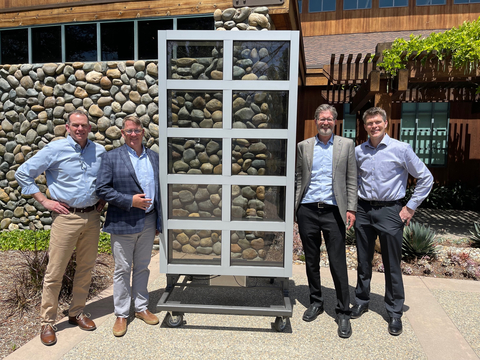Building Sustainability Into Building Supplies
MKM Building Supplies, the builder’s merchant, is stepping up its sustainability game by cutting carbon and boosting energy efficiency at its 135...
Read Full Article
Three months ago, Next Energy Technologies, a maker of a transparent photovoltaic coating and glazing firm Walters & Wolf, demonstrated that commercial windows might be converted in to energy-producing solar panels – the results are now in.
Although the theory had been tested over a number of years, it wasn’t until April 2022 that a PC Prototype Window Wall was built that showed that the aesthetics of the glass would not be affected and that a enough energy could be produced to give a return on investment.
The wall was created in collaboration with Next, Walters & Wolf and commercial glass fabricator Glassfab Tempering Services.
“Our project data shows these windows can help buildings reduce energy consumption by improving the efficiency of windows and generating electricity for the building.”
– Daniel Emmett
CEO, Next Energy Technologies
Net Zero goals
“To effectively mitigate climate change, we need to fundamentally rethink how we design, construct, power and manage our built environment,” adds Emmett. “Results of this project are significant given that commercial buildings account for 36% of all US electricity consumption at a cost of more than $190 billion annually. Additionally, windows represent 30% of a commercial building’s heating and cooling energy, costing US building owners about $50 billion annually.
“Combined with President Joe Biden’s new goal of the US government achieving net-zero greenhouse gas emissions by 2050, it is imperative that the commercial real estate and construction industries transform how buildings manage energy and where they get it.”
The tech
Next’s transparent energy harvesting technology allows architects and building owners to turn windows and glass facades into producers of low-cost, on-site, renewable energy for buildings. The photovoltaic technology is enabled by proprietary organic semiconducting materials that are earth-abundant and low-cost. This material is coated uniformly onto glass as an ink in a high-speed, low-cost, low-energy process, enabling the glass to harvest the sun’s light and convert it into electricity rather than heat.
In the test project, Next windows were modelled and tested against traditional commercial windows, tracking performance based on their respective Solar Heat Gain Coefficient (SHGC), an industry-standard performance metric for commercial windows. SHGC measures the amount of heat – or solar gain – created by sunlight passively entering buildings through windows. Excessive solar gain can lead to overheating within a space and inefficient energy management throughout a building.
The results of the study shows the technology could lower the SHGC from an otherwise equal window to something below .20.
Monumental challenge
Garret Henson, the vice president sales & marketing at Viracon, a manufacturer of architectural glass for commercial buildings in North America, said: “These are extremely significant results for the energy efficiency of insulating glass. Achieving a SHGC below .20 while providing neutral aesthetics has been a monumental challenge for all of us that create vacuum deposition architectural coated glass. Balancing performance and appearance is the heart of ideal harmony and it appears Next has done just that.”
Comparison
The lowering of the SHGC represents a median source energy savings of approximately 10% across all locations and a maximum source energy savings of up to 50% in some locations (e.g., New Mexico, Texas, and Arizona) compared to baseline scenarios for today’s traditional windows.
Picture: Just some of the team behind the project that produced a working PC Prototype Window Wall.
Article written by Cathryn Ellis
26th July 2022